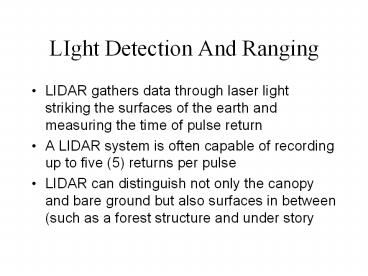LIght Detection And Ranging - PowerPoint PPT Presentation
1 / 11
Title:
LIght Detection And Ranging
Description:
LIDAR gathers data through laser light striking the surfaces of the earth and ... A LIDAR system is often capable of recording up to five (5) returns per pulse ... – PowerPoint PPT presentation
Number of Views:465
Avg rating:3.0/5.0
Title: LIght Detection And Ranging
1
LIght Detection And Ranging
- LIDAR gathers data through laser light striking
the surfaces of the earth and measuring the time
of pulse return - A LIDAR system is often capable of recording up
to five (5) returns per pulse - LIDAR can distinguish not only the canopy and
bare ground but also surfaces in between (such as
a forest structure and under story
2
A point cloud of multiple LIDAR returnsa topic
for on-going research estimating forest stand
volume for example
3
The most common use for LIDAR is the creation of
very high resolution DEMs
4
An interesting paper http//www.isprs.org/commiss
ion3/proceedings/papers/paper114.pdf
5
Why LIDAR?
- Potential exists for highly accurate Elevation
data sets. - Forestry, construction, even modeling radio
reception for cell towers depend on very accurate
elevation data - Many areas are too large (or difficult) to
manually survey, river flood plains, coastal
mudflats or sediment deposits
6
Conceptually quite simple, a single laser beam
sweeps back and forth beneath an aerial (or
space) platform. As the velocity of light is a
constant, the time from pulse to recording
provides a very accurate measure of height
7
Recording the back scatter
- typically use extremely sensitive detectors
called photomultiplier tubes to detect the
backscattered light. - Photomultiplier tubes convert the individual
quanta of light, photons, first into electric
currents and then into digital numbers - The amount of light required for a
photomultiplier tube to record data is very small
on the order of picoamps (1 pA 10-12 A a 60 W
light bulb draws a current of 0.5 A!).
8
The geometry of the platform is critical.and
variable (airplanes bounce!)
Accurate LIDAR data is completely dependent on
being able to know, and correct for changes in
platform orientation.
9
From the Spencer B. Gross web sitehttp//www.sbg
maps.com/lidar.htm
- The core of the system is the Inertial
Measurement Unit (IMU). The IMU measures the
translation and rotational dynamics of the
sensor. It is entirely solid state for high
reliability, containing a triad of high quality
silicon accelerometers, and three low noise Dry
Tuned Gyros. - It is non-trivial to actually create a worthwhile
data set.
10
Using LIDAR to understand the atmosphere
- Differential Absorption LIDAR (DIAL) uses 2 laser
pulses fired simultaneously one wavelength of
laser light is normal and transits the
atmosphere with no significant reflection or
absorption - The second wavelength of laser light is absorbed
by a specific gas (ozone or water vapor) in the
atmosphere
11
The UV DIAL system uses five laser (or lidar)
wavelengths IR and visible wavelengths both
measure aerosols and clouds. Two UV wavelengths
determine the profile of ozone by analyzing the
absorption differences due to ozone between the
two lidar returns. http//oea.larc.nasa.gov/PAIS
/DIAL.html































